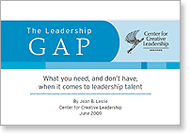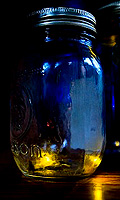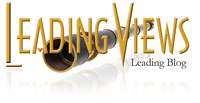 Leading Blog | Posts by Month |
 Leading Blog | Posts by Month |
11.30.09

LeadershipNow 140: November 2009 Compilation
Posted by Michael McKinney at 07:16 AM
11.26.09

Gratitude: The Habit of Noticing
GRATITUDE is a way of investing ourselves in others. A particularly overlooked aspect of the art of gratitude is the habit of noticing. When we notice others and show our appreciation, it pays huge dividends. Additionally, by noticing others we become more attuned to life’s vitality, intensity, and diversity. I related the following story from the book Growing the Distance, a few years ago, but it bears repeating: Arden Barker had planted a 50-acre field of wheat that was now golden-brown, very full, and ready for harvest. It was a sight to touch the heart of any farmer. When his Uncle Harry came to visit, Arden proudly took him out to look at the field of wheat. Harry looked around, put his hand over his eyes to peer into the distance, and fixed his gaze on a boulder that had been too large to move in the middle of the field. “Is that a stone on the hill?” he asked. He said nothing about the field of wheat. Arden was crushed by his lack of enthusiasm. Too often, leaders, managers, and parents think that it is crucial to their role to point out where people could improve—to be critical. Certainly, there is a time for that, but it happens all too often. Effective leaders will look for the positive and show gratitude and appreciation for it. People often look to others for direction and support and if it is not forthcoming it can kill the spirit and impede growth.
Posted by Michael McKinney at 12:19 AM
11.24.09

Newswire: 10 Crucial Consumer Trends for 2010
Posted by Michael McKinney at 09:31 AM
11.23.09

Do the Leaders within Your Organization Have the Skills They Need To Be Successful In the Future? Do the leaders within your organization have the skills they need to be successful in the future? This is the basic question that the Center for Creative Leadership asked 2,200 leaders from 15 organizations, in three countries between 2006 and 2008. Do the leaders within your organization have the skills they need to be successful in the future? This is the basic question that the Center for Creative Leadership asked 2,200 leaders from 15 organizations, in three countries between 2006 and 2008.
The findings from this research project identified the following seven leadership skills as most critical for success, now and in the future:
However, what I found interesting in the report was the following comment: “These data show that many leaders’ strengths are not in areas that are most important for success. Organizations report greater bench strength in areas ofThe above listed five skills were categorized as over-investments or competencies that are strengths but not considered important. (Additionally, confronting people, putting people at ease, managing one’s career were considered to be competencies that are not strengths and not considered important.) This finding struck me as rather odd for two reasons. First, these competencies are areas where we find people continually getting themselves into trouble and secondly, most of the nine competencies listed have a direct and even causal effect on the seven competencies that the participants found to be insufficient to meet future leadership requirements. Respecting individual differences and lack of self-awareness are two popular weapons of self-destruction. The fact that we think we have these skills sufficiently mastered to render them unimportant suggests that we have blind spots that have not been fully explored. Consultant Wally Bock rightly observed, “The ‘important’ list includes ‘leading people’ and ‘inspiring commitment.’ Those two are among the competencies that the respondents thought they were not good at. Maybe there wouldn’t be a gap on those competencies if they thought things like ‘building and maintaining relationships’ were important.” Absolutely correct. If leadership is about anything, it is about relationships. All our hopes, dreams, goals, metrics, sales, market share and aspirations are going to be accomplished through people. The “important” skills are founded on the “unimportant” skills. Learning how the nine “unimportant” competencies impact and drive the seven “important” competencies will help to fill the leadership gap now and for decades to come.
Posted by Michael McKinney at 05:32 AM
11.20.09

Lead Your Boss
A CAN-DO PERSON himself, Theodore Roosevelt once advised, “Do what you can, with what you have, where you are.” Roosevelt’s admonition is easier said than done. Most of us are not in a position to implement sweeping change by the wave of our hand. And some of us are in a counterproductive culture where sticking your head up is a good way to get it knocked off. But we can learn to do what we can, with what we have, from where we are.It means that we must learn the art of leading from the middle—from among rather than from in front. And if we are honest, in most contexts, we find ourselves leading from the middle. (CEOs included) We are trying to influence the people around us, above us and below us. So learning to appropriately and effectively lead in this way, will impact our success in most areas of life. John Baldoni has written a primer on leading from the middle with Lead Your Boss: The Subtle Art of Managing Up. What I appreciate about his writing is that it is down-to-earth, nuts-and-bolts, and easy to connect with. He is aware of the fact that it is not easy and can be fraught with peril. He writes, Those who lead from the middle are those who think big picture and can do what it takes to get things done so their bosses and their teams succeed….Those who succeed at leading from the middle also are artful and adept managers. Baldoni says that leading up begins with answering three questions: 1. What does the leader need?
As he suggests, this is a selfless act that speaks to the heart of leadership. It requires people who can think for themselves and take the initiative to make things happen. Answering the three questions, taking the initiative and making it happen is the trick and is the focus of the rest of the book. Lead Your Boss walks you through every critical step of leading up. It provides instruction for overcoming those inevitable obstacles and you’ll find tips and strategies for:
Leading up is not a solitary job. “Leading up requires the ability to develop the talents of others; this is important for two reasons,” writes Baldoni. “One, you need to demonstrate that you know how to lead others; and two, putting others into leadership positions gives you the time you need to think and act strategically, that is, to lead your boss and your team more effectively.” Below is a two and a half minute video that provides a good overview of the book by author John Baldoni: 
Posted by Michael McKinney at 03:26 PM
11.19.09

Changing Generational Expectations on Leadership
EARLIER this year La Piana Consulting issued a report as a part of their NonprofitNext Initiative, that explores the key trends shaping the future of the social sector. They identify five trends: Demographic Shifts Redefine Participation, Technological Advances Abound, Networks Enable Work to Be Organized in New Ways, Interest in Civic Engagement and Volunteerism Is Rising, and Sector Boundaries Are Blurring. The report states, “In this changing environment, transformation is not optional. The future will demand a collective rethinking of what it means to be an organization, how individuals define their work and how best to both compete and partner across many permeable boundaries.” Looking at the first trend, Demographic Shifts Redefine Participation, we see that as younger generations begin to dominate the workforce, they bring with them different values, expectations and the place of technology in achieving results. This of course, changes how they define participation. La Piana Consulting rightly asserts that “The challenge is not so much the wholesale changing of the guard that was feared, but the need to figure out how the generations can work together effectively now and in the future…. There are significant distinctions in how younger generations value, approach, and leverage engagement, transparency, technology, professional development, and work-life balance. These differences will have to be negotiated.” More foundationally, it changes how we approach leadership, the organizational culture and structure. How will working across generations change the way you do work? Church consultant Cynthia Ware, wrote on her blog >The Digital Sanctuary, that this means more team participation and leadership “sharing.” This almost always gets interpreted as leaderless or a kind of a feel-good, rudderless “hot-tub” leadership that is not heavy on results. Top-down leadership is not necessarily bad leadership but is often executed poorly. It is most often associated with command and control, which is something else. Authority comes with responsibility but is most effective when used sparingly. Ware eloquently clarifies the issue: “Top-down” leadership is not always controlling - yet it is usually perceived as such - which is reflected in the trend. In fact, headship, if functioning correctly, releases rather than restricts, empowers rather than dominates, etc. For each generation—old and new—this will require learning a new perspective on what it means to share leadership. It’s healthy. If leaders stop learning they stop leading.
Posted by Michael McKinney at 11:35 AM
11.17.09

Derailed: Five Lessons Learned from Catastrophic Failures of LeadershipDerailed is about the traps you and I can fall into. Sometimes they are the result of the sense of entitlement that leaders can fall prey to. Sometimes they are the result of thinking and behavior that has worked (we think) in the past, so why change it now? Sometimes they are the overuse of a strength that we have yet to discipline. Sometimes we don’t even have a clue, and so we get derailed and go around blaming others and asking, “Why me?”It can happen to anyone. And it is something we have to constantly be sensitive to because these traps are character issues that can disqualify us from leadership. Author Tim Irwin writes, “No matter how brilliant, charming, strategic, or commanding in presence a leader is, the consequences of a failed character are extraordinarily disabling and will bring down even the strongest among us. Similarly, if our character is inadequate, eventually, we will miss the warning signals and slam into a parked freight train.” To illuminate the impact and nature of derailment, Irwin profiles six leaders who, either through arrogance, lack of self-awareness, a sense of entitlement, greed, self-discipline, or a combination of any or all, derailed. Derailment is a process. Irwin suggests that there are five stages: a failure of self-/other-awareness, hubris, missed early warning signals, rationalizing, and finally, derailment. A lack of self-awareness is the foundation of all derailments. These are all issues of character. And stressful times only make us more of who we already are. Authenticity, self-management, humility, and courage are dimensions of character that, when properly developed, help us to avoid derailment. We can only be as good a leader as the character we possess. Derailment is not inevitable, but without attention to development, it is probable. He writes, “Derailment is especially rooted in the failure to prepare, to grow personally and professionally, and to develop the qualities needed to stay on track…. Attention to our development means we must be constantly alert and self-aware and have a lifelong commitment to learn, to grow, and to prepare.” To combat derailment you need to adapt five habits says Irwin. First, you need to develop a habit of openness. “Openness to feedback reflects our interest in being a learning, growing person.” Second is the habit of self-/other-awareness. “It is critical that we regularly tune into how others see us.” When we find a big difference, we have a blind spot that needs to be addressed.
We also need to develop a habit of accountability. “The leaders most susceptible to derailment refuse to have their opinions, decision, and actions questioned…. Accountability means that, even when we are not required to answer to others because of our position or corporate policy or law, we intentionally place ourselves in a relationship with someone who tests our motives and our actions.” Finally, is to develop the habit of resiliency. “Resiliency is the ability not only to bounce back from adversity but also to grow from it.” A clear sense of purpose widens our perspective and helps us to become more resilient. Sometimes, we need a wake-up call to finally deal with our own issues. But we can learn vicariously. And that’s the best way to learn if we have the discipline. Tim Irwin’s book is a great place to begin. A guide for asking the hard questions. Of Related Interest: 
Posted by Michael McKinney at 12:30 PM
11.15.09

Confirmation Bias In the Wall Street Journal, Jason Zweig writes about the specific application of a general issue: confirmation bias. It is a never-ending battle that affects all of us and is worth reading for the reminder. He offers specific ideas to counteract its pull that can be applied to whatever you are doing. Here are a few edited excerpts from Ignoring the Yes-Man in Your Head to introduce the issue: In short, your own mind acts like a compulsive yes-man who echoes whatever you want to believe. Psychologists call this mental gremlin the "confirmation bias." A recent analysis of psychological studies with nearly 8,000 participants concluded that people are twice as likely to seek information that confirms what they already believe as they are to consider evidence that would challenge those beliefs.
Posted by Michael McKinney at 11:57 AM
11.12.09

The Seven Deadly Sins of LeadershipPeter Drucker never wrote a book about leadership, but his thoughts about it are sprinkled throughout his 40 books and hundreds of articles. Bill Cohen has extracted these ideas and presented them in Drucker on Leadership.To Drucker, leadership was a calling and he set very high ethical standards for those that chose to lead. Character traps like losing sight of why you are leading, selfishness and the abuse of power often derails leaders. Drucker hoped, writes Cohen, “that by making these traps explicit he could help leaders avoid falling into them.” Cohen gathered Drucker’s thoughts about these shortcomings together and categorized them as the seven deadly sins of leadership: The Leadership Sin of Pride. “The sin of pride is usually considered the most serious of the seven deadly sins.” Being proud of one’s accomplishments is one thing. “The problem comes when leaders believe themselves so special that ordinary rules no longer apply. Generalized pride—as opposed to being proud of specific things—is the most serious leadership sin because it can easily lead to the other six.” The Leadership Sin of Lust. “There is unfortunately a feeling among some leaders that they have ‘arrived’ and are ‘entitled’; sex is seen as some sort of fringe leadership benefit….In any workplace, it creates jealousies, feelings of favoritism, and lack of trust, damaging people and relationships and more….Drucker thought that leaders did not pay enough attention to avoiding this particular deadly sin, and thought that leaders could do a better job of avoiding problems that affected their ability to lead.” The Leadership Sin of Greed. “The sin of greed is a sin of excess. It frequently starts with power. Leaders have power, and unfortunately having power has a tendency to lead to corruption if the leader isn’t careful. This may start with the acceptance of small favors and grow into accumulating vacations, bribes, or worse.” The Leadership Sin of Sloth. “For the leader, the sin of sloth is associated with an unwillingness to act. More often, it is an unwillingness to do work the leader considers beneath the dignity of the office.” The Leadership Sin of Wrath. “This sin has to do with uncontrolled anger. There is a time for anger in leadership when it serves a definite and useful purpose….Drucker taught leaders to analyse their environment and to determine what actions that had already occurred, meant for the future before taking action. Using anger as a single response to all leadership challenges precludes doing this analysis.” The Leadership Sin of Envy. “With the sin of envy, the leader is envious of what is enjoyed by someone else.” This may cause a leader to “attempt to destroy another’s reputation, or in other ways attempt to feel better by lowering the status of another.” The Leadership Sin of Gluttony. Of all the deadly sins, gluttony is the one that most frustrated Drucker. We typically associate gluttony with food, but it applies to excessive consumption of any kind. “Drucker did not win many friends among high executives with his injunction about too high salaries….It’s easy to rationalize—and a status issue. However, there was no question in Drucker’s mind but that executive hypercompensation was an accurate example of the sin of gluttony and was to be avoided for good leadership.”
Posted by Michael McKinney at 04:35 PM
11.11.09

Eisenhower: No Born LeadersThe one quality that can be developed by studious reflection and practice is leadership.In contrast to George S. Patton Jr., who felt himself born to lead men into desperate battle and who believed that all great leaders are leaders by virtue of their destiny, Dwight Eisenhower thought that leadership could be acquired, learned through “studious reflection and practice.” When his son, a West Point Cadet, expressed disappointment at having been promoted to ordinary cadet sergeant rather than given the distinction of promotion to color sergeant, Ike replied that it did “not indicate that you are lacking in the qualities of leadership” and explained that these qualities could be acquired. He went on to demystify leadership, telling his son that it was nothing more than the ability to “get people working together, not only because you tell them to do so and enforce your orders but because they instinctively want to do it for you…. You do not need to be a glad-hander nor a salesman, but your men must trust you and instinctively wish you to win your approbation and to avoid things that call upon you for correction.” Adapted from Eisenhower on Leadership by Alan Axelrod. Of Related Interest:
Posted by Michael McKinney at 07:52 AM
11.10.09

Marc Benioff: How We Went From Idea to Billion Dollar Company
MARC BENIOFF begins: “I started salesforce.com in a rented apartment in 1999 with the goal of making enterprises software as easy to use as a Web site like Amazon.com. That idea—to deliver business applications as a service over the Internet—would change the way businesses use sophisticated software applications and, ultimately, change the way the software industry works. In less than a decade, our business has grown from a simple idea to a public company with more than a billion dollars in revenue. We have achieved success by approaching business in a new way. The new models we have created…have been effectively employed by other companies, and we believe that any company can succeed with our strategies.” Behind the Cloud is divided into nine playbooks: Start-Up, Marketing, Events, Sales, Technology, Corporate Philanthropy, Global, Finance and Leadership. In these playbooks, 111 plays or lessons arise from the story of how they focused their vision, utilized available resources, overcame obstacles and measured their success that is woven through them. While the Plays themselves won’t blow you away, the stories behind them often provide great insight as to how they were implemented to build an extraordinary business. You'll find that many of them will resonate with whatever you are doing. Behind the Cloud is a fast, jargon-free read. The style is very open and down-to-earth and represents well the attitude and approach that made salesforce.com what it is today. 
Posted by Michael McKinney at 08:41 PM
11.09.09

Building Teams that Capitalize on the Innate Creativity of Everyone on the Team
“A lone firefly—like the lone genius—does not ignite the imagination of others,” writes Kimberly Douglas in The Firefly Effect. “It takes the brilliant light of many, and the creative effort of the entire team, to truly spark innovation with impact.” The job of the leader is to “create a safe environment in which every member of the team can knowingly and proudly claim those differences, and apply them in an optimal way to achieve the goals of the team.” The leader must provide the processes that will allow every other member of the team to see each other in this new light. These differences can create heat. “Fireflies know how to shine without creating heat—without wasting energy on unnecessary conflict.” Differences should compel us to look at individual differences more creatively. The team’s focus is key. “One of the most important things that a leader can do is keep the team focused on the real competition; those who exist outside the walls of the organization…. Making this the focus keeps people from clashing within the group. When this focus is lost, infighting and bickering among the team members thrives.” This means learning to communicate more and better. It means learning to view conflict in a new way; not as a destructive, inevitable evil, but rather as a constructive source of creative abrasion. The Firefly Effect is about releasing that spark of creativity that exists inside all of us and channeling it in a productive way. Douglas provides down-to-earth, tested and practical methods for inspiring your team and leveraging their innate abilities. She shows how you and your team can capitalize on what is right about the people on the team. 
Douglas provides much to think about and implement: Two key components drive powerful teams: where they’re going and how they’re going to work together to get there. The answers to these questions are inextricably tied. It simply means asking, you want to capitalize on team members’ unique differences to what end? You want to promote creativity and innovation targeted toward which business objectives, problems, or opportunities? In the end, Douglas illuminates the idea that “a single person has a substantial amount of power to truly make a difference in an organization by first believing in something, and then taking action on it.” That’s leadership. 
Posted by Michael McKinney at 10:34 AM
11.03.09

Leading Views: Winning Hearts and Minds Smart people with great credentials often self-destruct because they fail to connect with the people they are trying to influence. Both teachers and leaders must win the hearts and minds of those they lead. Without an emotional connection, both students and employees are just getting through the day. Leaders must learn to focus on the human side if they are to be effective. In Fierce Leadership author Susan Scott shares the difference between good teachers and bad teachers: Smart people with great credentials often self-destruct because they fail to connect with the people they are trying to influence. Both teachers and leaders must win the hearts and minds of those they lead. Without an emotional connection, both students and employees are just getting through the day. Leaders must learn to focus on the human side if they are to be effective. In Fierce Leadership author Susan Scott shares the difference between good teachers and bad teachers:
What makes for a bad teacher? Things like rigid control, broadcasting from the front of the room, and yes/no, right/wrong feedback. What makes for a good teacher? Things like creating a “holding space” for lively interaction, flexibility in how students become engaged in a topic, a regard for student perspective, the ability to personalize the material for each student, responding to questions and answers with sensitivity, and providing high-quality feedback “where there is a back-and-forth exchange to get a deeper understanding.” Sounds like the behavior of a good leader.
Posted by Michael McKinney at 04:30 PM
11.02.09

Nestlé's Paul Bulcke on Staying the CoursePaul Bulcke became chief executive of Nestlé SA in April 2008. An inauspicious time to take over the world's largest food company. Deborah Ball reports on an interview with Bulcke. In the short (2:35 min) video embeded below, he reflects on being authentic, developing a culture of competitive intensity and making people feel they have ownership.He says, “If your strategy is right, stick to the strategy. Maintain your inspiration which is long term, but do act short term.” Here is a brief excerpt from the article: WSJ: What is the worst piece of management advice you've received on how to deal with a downturn?Bulcke adds, “We are a long-term company. We are not going to do what I sometimes call "Hoopla" management, and do something damaging. We will be responsible.” Of Related Interest:
Posted by Michael McKinney at 09:53 AM
11.01.09

First Look: Leadership Books for November 2009Here's a look at some of the best leadership books to be released in November.




For bulk orders call 1-800-423-8273
Posted by Michael McKinney at 10:57 PM
|
BUILD YOUR KNOWLEDGE


How to Do Your Start-Up Right STRAIGHT TALK FOR START-UPS 
Grow Your Leadership Skills NEW AND UPCOMING LEADERSHIP BOOKS 
Leadership Minute BITE-SIZE CONCEPTS YOU CAN CHEW ON 
Classic Leadership Books BOOKS TO READ BEFORE YOU LEAD |
|